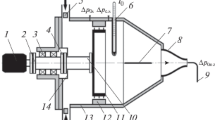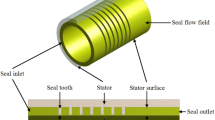Abstract
Leakage characteristics, influenced by centrifugal and thermal radial growth are determined computationally for a generic rotating labyrinth seal used in the gas turbine secondary air system. Three seal locations, namely, R25, R50 and R75 are represented by means of varying the rotor radius mimicking different radial positions of the seal from the shaft axis. The combined influence of seal location and its radial (Centrifugal and thermal) growth on the leakage performance is investigated for a wide-ranging speeds from 1000 to 3000 rad/s, temperatures ranging from 200 to 450 °C and pressure ratios varying from 1.1 to 2.5, for a chosen initial clearance of 500 micron. A comparison of the effect of rotation and temperature gradient among different rotors shows that the radial growth and leakage flow rates significantly vary with the increasing radius.
Similar content being viewed by others
References
H. J. Sneck, Labyrinth seal literature survey, Journal of Lubrication Technology, 96 (4) (1974) 579–581.
M. Hwang, A. N. Pope and B. Shucktis, Advanced seals for engine secondary flow path, AIAA Journal of Propulsion and Power, 12 (4) (1996) 794–799.
R. E. Chupp, R. C. Hendricks and S. B. Lattime, Sealing in turbomachinery, AIAA Journal of Propulsion and Power, 22 (2) (2006) 313–349.
J. W. Chew and N. J. Hills, Computational fluid dynamics for turbomachinery internal air systems, Philosophical transactions of the royal society A: Mathematical, physical and engineering sciences, 365 (1859) (2007) 2587–2611.
F. E. Aslan-zada, V. A. Mammado and F. Dohnal, Brush seals and labyrinth seals in gas turbine applications, Proceedings of the institution of mechanical engineers, Part A: Journal of Power and Energy, 227 (2) (2013) 216–230.
S. Wittig, U. Schelling, S. Kim and K. Jacobsen, Numerical predictions and measurements of discharge coefficients in labyrinth seals, ASME, International Gas Turbine Conference and Exhibition, Anaheim, CA. ASME paper GT1987-188 (1987).
D. W. Childs and J. M. Vance, Annular gas seals and rotordynamics of compressors and turbines, Proceedings of 26th Turbomachinery Symposium, Texas, USA (1997) 201–220.
B. V. S. S. S. Prasad, V. Sethumanavalan and N. Nanjundarao, Computational and experimental investigations of straightthrough labyrinth seals, ASME Paper GT1997-326 (1997).
B. V. S. S. S. Prasad, V. Sethumanavalan and N. Nanjundarao, Analysis of leakage flow through inclined labyrinth seals, The Seventh Asian Congress of Fluid Mechanics, Allied Publishers (1997).
N. Nanjundarao, V. Sethumanavalan, B. V. S. S. S. Prasad and O. Hanumakumar, Computational and experimental investigations of leakage flow through radial labyrinth seals, 9th ISROMAC, Hawaii, USA (2002) DD-ABS-072.
T. S. Kim and K. S. Cha, Comparative analysis of the influence of labyrinth seal configuration on leakage behavior, Journal of Mechanical Science and Technology, 23 (10) (2009) 2830–2838.
M. P. Proctor and I. R. Delgado, Leakage and power loss test results for competing turbine engine seals, ASME paper GT2004-53935 (2004).
I. R. Delgado and M. P. Proctor, Continued investigation of leakage and power loss test results for competing turbine engine seals, Paper No. NASA / TM-2006-214420 (2006).
R. Paolillo, C.-Z. Wang, T. K. Vashist, D. Cloud, F. M. G. Bingen and G. A. Kool, Rotating seal rig experiments: test results and analysis modeling, Proceedings of ASME Turbo Expo 2006: Power for Land, Sea, and Air (2006) 1551–1559.
R. Paolillo, S. Moore, D. Cloud and J. A. Glahn, Impact of rotational speed on the discharge characteristic of stepped labyrinth seals, Proceedings of ASME Turbo Expo 2007: Power for Land, Sea, and Air (2007) 1291–1298.
Z. Li, J. Li, X. Yan and Z. Feng, Effects of pressure ratio and rotational speed on leakage flow and cavity pressure in the staggered labyrinth seal, ASME Journal of Engineering for Gas Turbines and Power, 133 (11) (2011) 114503.
A. M. Gamal, B. H. Ertas and J. M. Vance, High-pressure pocket damper seals: leakage rates and cavity pressures, ASME Journal of Turbomachinery, 129 (4) (2007) 826–834.
Z. Li, J. Li, X. Yan and Z. Feng, Numerical investigations on the leakage flow characteristics of pocket damper labyrinth seals, Proceedings of the Institution of Mechanical Engineers, Part A: Journal of Power and Energy, 226 (7) (2012) 932–948.
J. Li, B. Qiu and Z. Feng, Experimental and numerical investigations on the leakage flow characteristics of the labyrinth brush seal, ASME Journal of Engineering for Gas Turbines and Power, 134 (10) (2012) 102509.
D. Amirante, N. J. Hills and C. J. Barnes, Use of dynamic meshes for transient metal temperature prediction, ASME Paper GT2012-68782.
V. Ganine, U. Javiya, N. Hills and J. Chew, Coupled fluidstructure transient thermal analysis of a gas turbine internal air system with multiple cavities, ASME Journal of Engineering for Gas Turbines and Power, 134 (10) (2012) 102508.
S. Subramanian, A. S. Sekhar and B. V. S. S. S. Prasad, Performance analysis of a rotating labyrinth seal with radial growth, ASME Turbo Expo 2013, ASME Paper GT2013-95708, San Antonio, USA (2013).
S. Subramanian, A. S. Sekhar and B. V. S. S. S. Prasad, Influence of location on leakage performance of a rotating labyrinth gas turbine seal with radial growth, 15th ISROMAC, Paper No. 2014-232, Hawaii, USA (2014).
T. Hirano, Z. Guo and R. G. Kirk, Application of computational fluid dynamics analysis for rotating machinery-part ii: labyrinth seal analysis, ASME Journal of Engineering for Gas Turbines and Power, 127 (4) (2005) 820–826.
INCONEL 718 properties, www.specialmetals.com/documents/Inconel alloy 718.pdf.
ANSYS Mechanical 14, Element description, ANSYS Users Guide (2011).
S. P. Timoshenko and J. Goodier, Theory of elasticity, McGraw-Hill Book Company, New York, USA (1997).
K. M. Melcher and J. A. Kypuros, Toward a fast-response active turbine tip clearance control, Proceedings of the International Symposium on Air Breathing Engines ISABE 2003-1102 (2003).
L. S. Andres and Z. Ashton, Comparison of leakage performance in three types of gas annular seals operating at a high temperature (300°c), Tribology Transactions, 53 (3) (2010) 463–471.
Air properties, http://www.engineeringtoolbox.com.
Author information
Authors and Affiliations
Corresponding author
Additional information
Recommended by Associate Editor Tong Seop Kim
A. S. Sekhar is currently a Professor of Mechanical Engineering and Head of Machine Design Section at IIT Madras. He has been awarded the Career Award for Young Teacher by the All India Council of Technical Education in1998. He did research at TU Darmstad, Germany as an Alexander von Humboldt Research Fellow in 2002. He has published over 150 papers in internationaljournals and conferences. He is the co-author of the book-Dynamic Analysis of Rotating Systems and Applications (Multi Science Publishing Ltd., UK). He is an editorial member of the Journal of Advances in Mechanical Engineering (Hindawi Publishing Corporation). His areas of research include rotor dynamics, condition monitoring and vibrations.
B. V. S. S. S. Prasad is currently a Professor and Head of Mechanical Engi- neering at IIT Madras, Chennai. He is also the principal coordinator of the CFD Centre at IIT Madras. He published more than 150 research papers in various international journals and conference proceedings. He edited 7 conference proceedings and organized several conferences and workshops. His research areas include thermo fluid dynamics related to turbomachines, energy conversion technologies and CFD. He is a life member of K-14 (Heat Transfer) group of IGTI (ASME), Fluid Mechanics and Fluid Power Society, Indian society for Heat and mass Transfer, Instrument Society of India and Fluid Power Society of India.
Sivakumar Subramanian obtained a Bachelor’s degree in Mechanical Engineering from Madurai Kamaraj University, India and Master’s degree from IIT Madras. Presently, he is pursuing his Doctoral studies at IIT Madras. His current research focuses on design and analysis of gas turbine seals with emphasis on leakage and rotor dynamic characteristics. His broad areas of interest include Gas turbine secondary air system, Rotor dynamics, Applied FEM/CFD, Condition monitoring and machinery diagnosis. He is a life member of Indian Society for Technical Education.
Rights and permissions
About this article
Cite this article
Subramanian, S., Sekhar, A.S. & Prasad, B.V.S.S.S. Influence of combined radial location and growth on the leakage performance of a rotating labyrinth gas turbine seal. J Mech Sci Technol 29, 2535–2545 (2015). https://doi.org/10.1007/s12206-015-0545-8
Received:
Revised:
Accepted:
Published:
Issue Date:
DOI: https://doi.org/10.1007/s12206-015-0545-8




